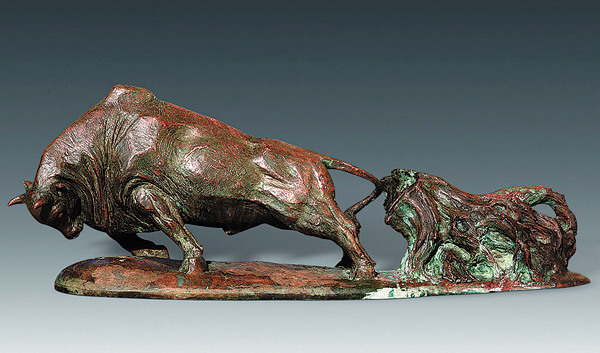

The Ploughing Bull, 35.5/102 cm, sculpture by Pan He. Photos Provided to China Daily
The 37-meter-long arced wall inside the National Art Museum of China is seen as one of the country's most important exhibition spaces. The wall, which is in the middle of the first floor's center hall, is usually reserved for the best work of blue-chip artists.
At the current exhibition that celebrates NAMOC's 50th birthday, there are no paintings hanging on the wall.
Instead, curators have listed the names of several hundred major exhibitions at NAMOC since its opening. On the arced wall, in big characters, they list the names of dozens of people who have made donations.
The exhibition, titled Along with the Times, is a retrospective with 666 paintings, prints, sculptures, caricatures, installations and mixed-media works from NAMOC's collections, which together narrate a condensed history of Chinese art in the 20th century.
It features such well-known paintings as Luo Zhongli's Father and Xu Beihong's Horse, as well as masterpieces that are on show for the first time, like Jiang Zhaohe's hand scroll Refugees.
The exhibition occupies NAMOC's 14 halls but reflects just the tip of the iceberg, as the museum has 110,000 stored works, which range from ancient Chinese paintings and calligraphy, to modern fine arts, folk and Western art.
The collection was accumulated in tandem with NAMOC's construction. In 1961, a three-person team started collecting and purchasing and shortly after that came the first contribution - 116 ink-and-water paintings of Chen Shuren, one of the "three masters of the Lingnan School" - from his wife Ju Ruowen. By the time the museum was opened, it boasted a collection of nearly 5,000 works.
Three years later, Deng Tuo, an intellectual and journalist, donated 145 works and sets of paintings, several of which were appraised as national treasures. Deng's generosity inspired more artists and their families to do the same.
NAMOC's deputy director Liang Jiang says the museum's collection experienced explosive growth after the "cultural revolution" (1966-76).
One remarkable contribution was Refugees, the most influential work of Jiang Zhaohe, which his family donated in 1998. Jiang, a reformer of figurative painting, adopted a Realist approach to reveal the hardships of poor people and cruelty of society. The huge ink painting is 2 meters tall and 12 meters wide.
Copyright ©1999-2018
Chinanews.com. All rights reserved.
Reproduction in whole or in part without permission is prohibited.